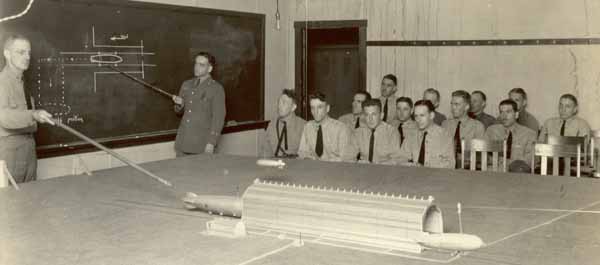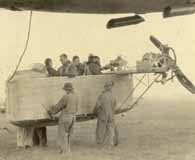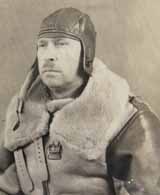Journey To Obsolescence: The Army Air Corps Lighter-Than-Air Branch – Part 3

Editor’s Note: This article is the third installment from Maj. Gen. (ret.) Neal Creighton’s Journey To Obsolescence. Please click here to read Part 1 or here to read Part 2.
On July 2, 1926, U.S. President Calvin Coolidge signed what became known as the Air Corps Act, replacing the Air Service with the Army Air Corps designation. Major General Mason Patrick still headed the organization, but was now the recipient of the title “Chief of the Army Air Corps.” This change moved Patrick to create a five-year plan of reorganization, a plan that was destined to become the beginning of the end of the U.S. Army’s Lighter-Than-Air (LTA) Branch and end the hopes and dreams of its protagonists.
{default}By this time, the status of the early LTA proponents was: Charles Chandler had retired; John Jouett was serving on General Patrick’s staff in Washington, D.C.; Oscar Westover was commanding Langley Field; John Paegelow was in his fourth year as Commandant of the Balloon and Airship School at Scott Field; William Kepner was getting ready to become his deputy; Neal Creighton was serving as the School’s Secretary and Chief of Operations; Frank Kennedy had just recently returned from Germany where he observed construction of the Navy dirigible USS Los Angeles; Jacob Wuest was scheduled to become a student at the Balloon & Airship School the following year; and Orvil Anderson had just returned to Scott Field to command the 8th Airship Company. However, it is unlikely that any of them realized at that time that the path they had chosen for their career specialty was on the road to obsolescence.
As the new Air Corps Five year plan was taking shape in 1926, the competition between the LTA proponents and the Heavier-Than-Air (HTA) supporters was rapidly changing to favor the latter. Airship technology was falling far behind the airplane. Since the end of World War I, the latter had developed the ability to go faster, fly higher, and remain in the air longer. General Billy Mitchell had gained headlines with his bombing tests in 1921 which he claimed proved that airplanes were capable of sinking battleships. Army airplanes flew non-stop across the United States in 1922 and around the world in 1924, though it did take them 175 days for that trip. By 1926, military airplanes were being equipped with radios that allowed them to communicate with ground stations as well as with other aircraft. Whereas the World War I planes were not routinely equipped with a supply of oxygen for operating at higher altitudes, that equipment was now standard. And, HTA pilots were supplied with parachutes beginning in the years after the war, a change that was to save many lives and make flying a safer occupation.
The Army Air Service’s HTA elements also early-on realized the importance of public relations. Army airplanes and pilots, including Lt. Jimmie Doolittle, competed in air races and air shows across the country. And, in the civilian arena, Northwest Airlines was the first U.S. airline to begin commercial operations, flying mail and passengers to and from Alaska. Ford Motor Company entered the airplane business in 1925 and soon produced a 12-passenger Trimotor plane that was to become the first successful airliner. Pan American Airlines began its operations in 1927 carrying cargo and passengers to Miami, the Florida Keys, and Havana. And a company called Douglas had developed a design for a commercial aircraft that would later become famous as a cargo carrier, the DC-3. Then, Charles Lindberg electrified the world with his solo non-stop flight across the Atlantic in 1927.
 Meanwhile, the LTA Service suffered some major setbacks during the 1920s, the Roma crash being one of them. Also in 1925, the Navy’s largest rigid airship, the Shenandoah, was brought down by a violent storm that killed 14 of the ship’s crew of 43. In an era where all the military services were competing for funds to support operations and allow development of new equipment, the LTA Service, with few airships and not many technical advancements to increase its military value, was losing ground.
Meanwhile, the LTA Service suffered some major setbacks during the 1920s, the Roma crash being one of them. Also in 1925, the Navy’s largest rigid airship, the Shenandoah, was brought down by a violent storm that killed 14 of the ship’s crew of 43. In an era where all the military services were competing for funds to support operations and allow development of new equipment, the LTA Service, with few airships and not many technical advancements to increase its military value, was losing ground.
To men like Chandler, Westover, and Jouett it was clear that, if the LTA Service was to continue to exist, then new uses for lighter-than-air needed to be explored. They proffered ideas to use airships to carry troops and supplies across the oceans in time of war, pointing out that this could be done by airships much faster than by sea-going vessels. Other options were to use airships to patrol our nation’s borders; protect its ports; accomplish long range reconnaissance and bombing missions; support during civil disasters; and even to serve as docking stations for heavier-than-air aircraft.
When General Patrick’s new five year plan was finalized, it called for major increases in HTA aircraft squadrons, but no equivalent expansion of LTA elements or equipment. The Balloon and Airship School at Scott Field was retained, reporting directly to the Office of the Chief of the Army Air Corps. The plan called for the reactivation of two of the World War I balloon companies to be organized and stationed at Fort Sill and Fort Bragg. One airship company and a group headquarters were retained at Scott Field to support the school operations there. One airship company at Langley Field was also authorized with the mission of supporting coast artillery operations and training.
Because of very limited military budgets approved by Congress in the mid-1920s, Patrick was directed to carry out his reorganization plan without any increase in appropriations. Without any other recourse, Patrick was thereby forced to carry out his plan by making cuts in his existing budget. Soon this edict was to make the LTA force a target for the needed funds to create what Patrick envisioned as his priority objective, an expanded number of aircraft squadrons.
The most vulnerable portion of the LTA force authorized in the 1926 plan was the Balloon & Airship School at Scott Field. Since the plan envisioned no increase of units, the LTA force now found itself with more trained airship pilots than airships for them to fly. Noting this, Patrick ordered the suspension of School operations after the graduation of the last class of officers in June 1928. Jacob Wuest, the oldest pilot to graduate from the School, was a member of that final class.
 Creighton, the School Secretary and Operations Office found himself without a job and was dispatched to Fort Sill to command the 1st Balloon Company (later designated as a Squadron). Paegelow remained as the commander of Scott Field until his retirement in 1933. He was then succeeded by Kennedy.
Creighton, the School Secretary and Operations Office found himself without a job and was dispatched to Fort Sill to command the 1st Balloon Company (later designated as a Squadron). Paegelow remained as the commander of Scott Field until his retirement in 1933. He was then succeeded by Kennedy.
In 1926 before the new reorganization of the Air Corps, there had been balloons and airships of the Air Service stationed at 10 different locations around the United States. By the time the plan was completed in the early 1930s, the LTA element operated out of 4 locations (Scott, Langley, Sill, and Bragg) and had only 4 airships, 13 spherical balloons, and 4 observation balloons. Jouett, who had been one of the two Corps-level balloon commanders in World War I, resigned in 1930, leaving the Army after 16 years of service for an opportunity in civil life. He did, however, remain as a Reserve officer for another ten years. Many of the LTA career officers, including Kepner and Orvil Anderson, chose to become airplane pilots and were to spend the rest of their careers with the HTA forces.
Jacob Wuest became the commander of Langley Field after his graduation from the last Balloon & Airship School class. Upon completing that assignment in 1931, he was selected to be the U.S. Assistant Military Attaché for Air to Germany and Austria as well as several other countries in Central Europe. The next year, he became the Air Attaché in Berlin where, for three more years, he had a front row seat observing Adolph Hitler and his Nazi henchmen seize and consolidate their power.
However, there was one remaining advocate of the LTA who was in a position to make a difference in the future of that branch of the Air Corps, Oscar Westover. Promoted to Brigadier General in 1931 and named as Assistant to the Chief of Army Air Corps, Westover remained a supporter of his former associates still serving in the LTA units. And, they couldn’t have been more delighted when, in 1935, he ascended to the top job as Chief of the Army Air Corps. Unfortunately for them, and ironically for Westover, it was during his tenure as Air Corps Chief that the airship era in the U.S Army officially came to its end.
Westover’s predecessor as Chief of the Army Air Corps, Major General Benjamin Foulois, who himself had been an airship pilot, had recommended that the LTA program be eliminated. Many in Congress agreed with him. Westover soon found himself under pressure to take this step, but he was able to prolong the decision until financial pressures finally led him to agree to terminate airship operations in 1937. However, even though he announced this decision publically, he had his staff develop a plan to reinstitute the Balloon and Airship School at Brooke Field in Texas in 1938. The plan envisioned moving men and equipment from Scott to Brooke along with a cadre of 10 officers and 130 enlisted men. The plan was in much detail, including the names of 23 officers who should be considered for this assignment.
This staff action was submitted to the War Department on August 9, 1938. It was still in the staffing process in September of that year when its initiator, Major General Oscar Westover, died when the plane he was piloting burst into flames during a landing at the Lockheed plant at Burbank, California. Westover’s plan for reinstituting the LTA branch died with him that day.
In 1938, Scott Field was converted to an HTA post. The huge airship hanger was taken down and as was the mooring mast. The airships and supporting equipment of the LTA Branch were offered to the Navy. That which the Navy did not take was sold as excess. By the middle of 1939, the only LTA units in existence in the U.S. Army were 3 Balloon Squadrons located at Fort Bragg, Fort Sill, and Fort Lewis. Westover’s successors as Chief of Air Corps had no desire to continue the LTA branch. The 3 Balloon Squadrons that survived remained in the active force until the United States entered World War II in 1941. However, they ceased to exist in 1942. One converted to a barrage balloon unit and the other two were taken off the Army’s roles.
The Army Air Corps Lighter-Than -Air branch then became a part of history that is mostly forgotten.
What Became of the LTA Pioneers:
Colonel Charles deforest Chandler died in 1939, living long enough to see the demise of his beloved LTA organization. His last book, How Our Army Grew Wings, co-authored by General Frank Lahm, was published three years after his death.
Colonel John Albert Paegelow, after his retirement in 1933, moved to California, Missouri, the home town of his wife. Disappointed in not being recalled to active duty in World War II, he served on several wartime boards. He died in December of 1944. The Paegelow estate provided the town of California a youth center and a library with one of its rooms being a memorial to the Colonel.
Lt. Colonel (Ret) John H. Jouett, who left active duty in 1930, eventually retired from his second career and moved to the Virgin Islands. He died there in October 1968.
Lt. General William E. Kepner transferred to the HTA force in 1931. In World War II, he served in command positions with the 8th Air Force in Europe, including Deputy Commander. After the war, he served in key Air Force assignments finally serving as Commander-in Chief of the Alaskan Command. He retired in 1953 after 44 years of active duty and died in Orlando, Florida in 1982.
Orvil Anderson also served with the 8th Air Force in England during World War II, where he was promoted to Major General in 1944. After the war, he commanded the Air War College at Maxwell Field, Alabama. He retired in 1950 and later became the Director of the Air Force Historical Foundation. He passed away in 1965.
Colonel Frank Kennedy, after serving as commander of Scott Field from 1933 to 1937, spent the majority of the rest of his career on the staff of the Chief of the Army Air Corps. His last assignment on active duty was as commander of Fairchild Field at Spokane, Washington. He retired in 1944 and passed away in March 1965.
Colonel Jacob Wuest departed his attaché post in Berlin just months before Hitler began World War II in 1939 and, once again, became the commander of Langley Field. He was officially placed on the retired list in June 1942 after forty years of service. Recalled to active duty the following day, he served two more years of stateside duty before finally retiring in 1944. He died at the age of 96 at his home in Orlando, Florida.
Neal Creighton was commanding Pope Field and the Second Balloon Squadron when the Japanese attacked Pearl Harbor on December 7, 1941. That Balloon Squadron was deactivated in January of 1942. Six months later, Creighton departed the United States for England with the lead elements of the 8th Air Force. There he served for two and a half years as the unit’s Headquarters Commandant. In late 1944, he returned to the States and became the commander of Scott Field and Commandant of the Air Corps Radio School located there. He retired in 1947 from the U.S Air Force and died in July of 1965. Your author of this article attended his burial services, as he was my father. He was laid to rest on a hill at the Fort Rosecrans National Cemetery. From there, one can see the beautiful San Diego harbor filled with ocean-going ships from around the world plus the many airplanes taking off and landing at the commercial airport. What you probably will never see are military lighter-than -airships peacefully floating above the harbor’s surface for they, like the LTA pioneers, now belong to the ages. RIP!
Major General, ret. Neal Creighton, whose distinguished military career included command of the U. S. 1st “Big Red One” Infantry Division, is the author of “A Different Path: The Story of an Army Family” (Xlibris, 2008).

